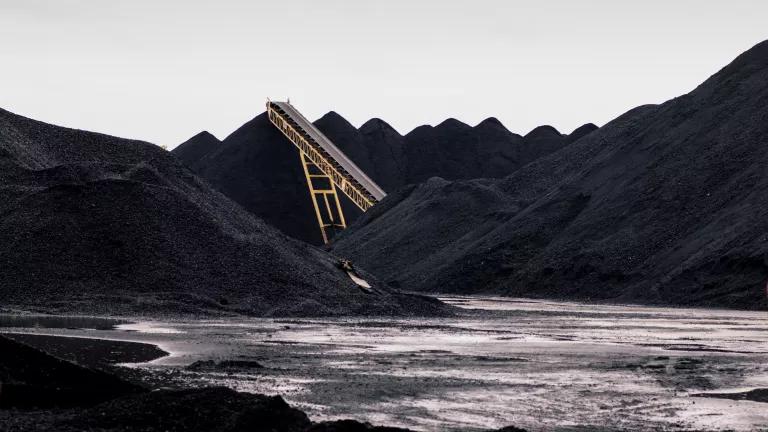The Petcoke Problem: Where to Store the Risky Tar Sands Refining By-Product
Petroleum coke, typically stored outdoors in big open piles, can blow right into nearby homes and cause serious health problems. Unsurprisingly, communities are fighting Big Oil to keep this noxious material out of their backyards.

Coal piles in Green Bay, Wisconsin
Plenty is known about the environmental downsides of Canadian tar sands oil. Extracting it destroys the Canadian wilderness; processing it is terrible for the climate; a spill is nearly impossible to clean up. But there is another serious consequence of extracting oil from tar sands that is gaining new attention: the human health risks posed by petcoke, the noxious by-product of the refining process. All oil refining creates petcoke, but tar sands and other heavy oils create a lot more of it.
The petcoke issue received increased national scrutiny in 2013 as piles began to accumulate in major cities like Detroit and Chicago. BP had recently finished expanding its Whiting, Indiana, refinery, just outside Chicago, to process significantly more tar sands crude arriving from Canada. As a result of the expansion, BP’s petcoke production increased nearly fourfold. Petcoke from the Whiting refinery piled up outside the KCBX terminal, a transfer station. (KCBX is a subsidiary of Koch Industries, a Koch brothers company.) Dust from the facilities blew across the street and came to rest on homes, schools, and playgrounds—and in children’s lungs. Residents complained that the thick black film even got into some homes.
They were right to complain. Even at the time, experts recognized that petcoke dust is a form of PM10—the airborne particulate matter that’s just the right size to sneak into the human respiratory system and trigger asthma and cardiovascular disease. And some experts believe that petcoke is even more problematic than coal in terms of the amount of dust generated. “Petcoke is particularly bad because it’s so friable, meaning it’s even finer than coal dust and blows around more easily,” says Meleah Geertsma, a senior attorney in NRDC’s Midwest program.

In late August of this year, the U.S. Department of Health and Human Services confirmed that the Chicago petcoke dust was a significant risk to human health. The government concluded that, notwithstanding KCBX’s attempts at obfuscation, the facilities were the predominant source of particulate matter and vanadium, a heavy metal, measured at fence-line monitor locations. This report also confirmed that the city of Chicago had been justified in banning BP and KCBX from parking petcoke in outdoor piles as of summer 2016.
But the petcoke didn’t disappear—BP just sent it to other transfer stations in places like Green Bay, Wisconsin; a terminal near Paducah, Kentucky; and Newport News, Virginia.
People in Newport News have been fighting over air quality since 1984, when the Terminal Avenue transfer station opened at the mouth of the Chesapeake Bay to handle coal and other industrial products. A 2005 study showed that asthma is more than twice as common among people living in the area around the coal piles as it is in the rest of the city and state. And now, BP’s petcoke will be contributing to the problem there. The operators of Terminal Avenue have made some technical improvements to limit blowing dust―for example, installing sprinklers, the same type of control employed at the Chicago sites. But residents say the problem persists. Prevailing winds whip across the top of the piles and carry coal dust and petcoke into nearby homes. At a Sierra Club news conference in April 2015, Michael Beane, who lives near Terminal Avenue, said, “I can't even use my upstairs porch because it's covered in coal dust.”

If petcoke is unsafe near homes and playgrounds in Chicago, as the federal government recently confirmed, there’s no reason to believe it’s safe near homes and playgrounds in Newport News. To make matters worse for people living near Terminal Avenue, the government of Newport News has shown little appetite to place limits on the industrial behemoth polluting the local environment. At least Chicago (and state and federal regulators) took action once it recognized the health risks of black soot blowing through its neighborhoods.
Petcoke has now become a game of political whack-a-mole, as environmental and public health advocates chase the dangerous dust from community to community, hoping that government officials will soon implement a safe and workable solution to keep every community safe.
“Communities across the country that lack protections from similar coke and coal handling facilities deserve better,” Geertsma writes. “It’s our hope that Chicago can serve as a rallying cry for needed changes nationwide, and itself step up to eliminate any remaining impacts from these dirty facilities.”
This NRDC.org story is available for online republication by news media outlets or nonprofits under these conditions: The writer(s) must be credited with a byline; you must note prominently that the story was originally published by NRDC.org and link to the original; the story cannot be edited (beyond simple things such as grammar); you can’t resell the story in any form or grant republishing rights to other outlets; you can’t republish our material wholesale or automatically—you need to select stories individually; you can’t republish the photos or graphics on our site without specific permission; you should drop us a note to let us know when you’ve used one of our stories.

Mercury’s Journey from Coal-Burning Power Plants to Your Plate
Environmental Justice in Chicago: It’s Been One Battle After Another
The Connection Between Mass Incarceration and Environmental Justice